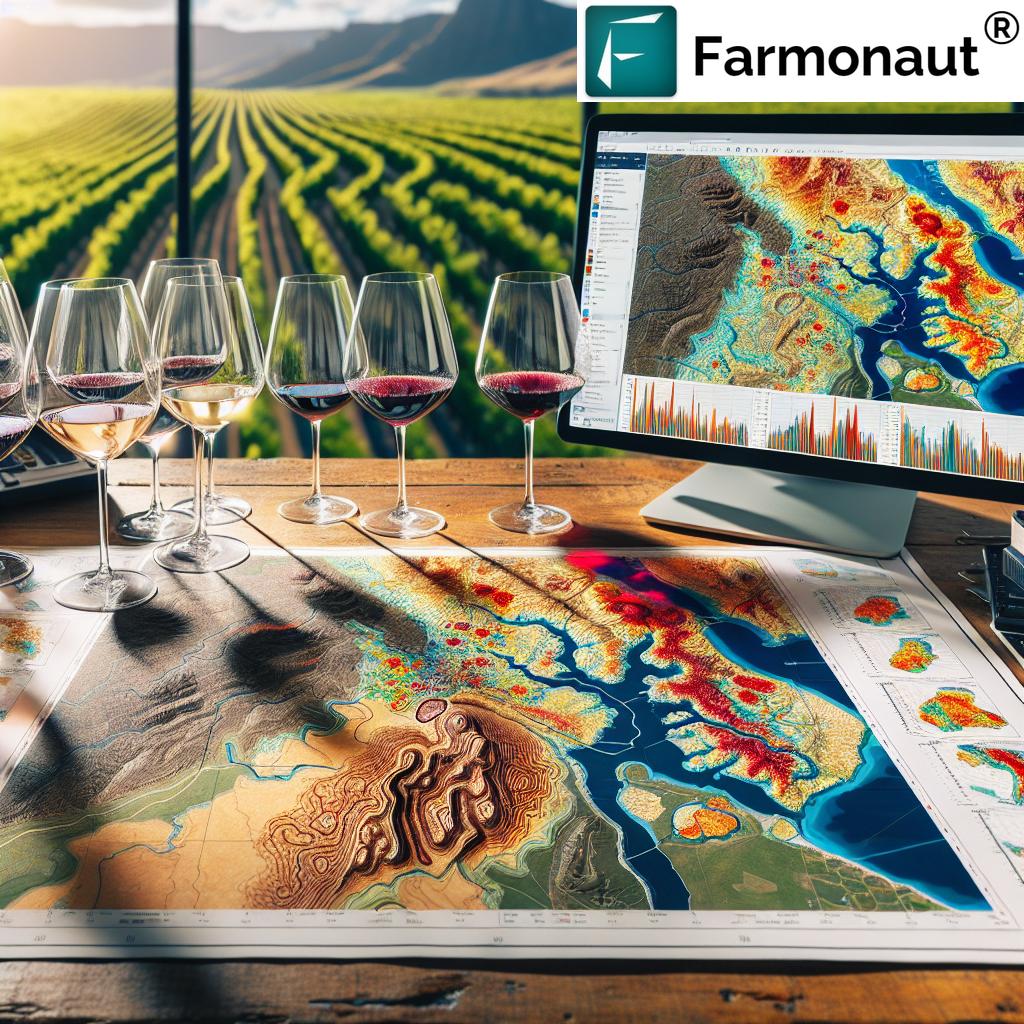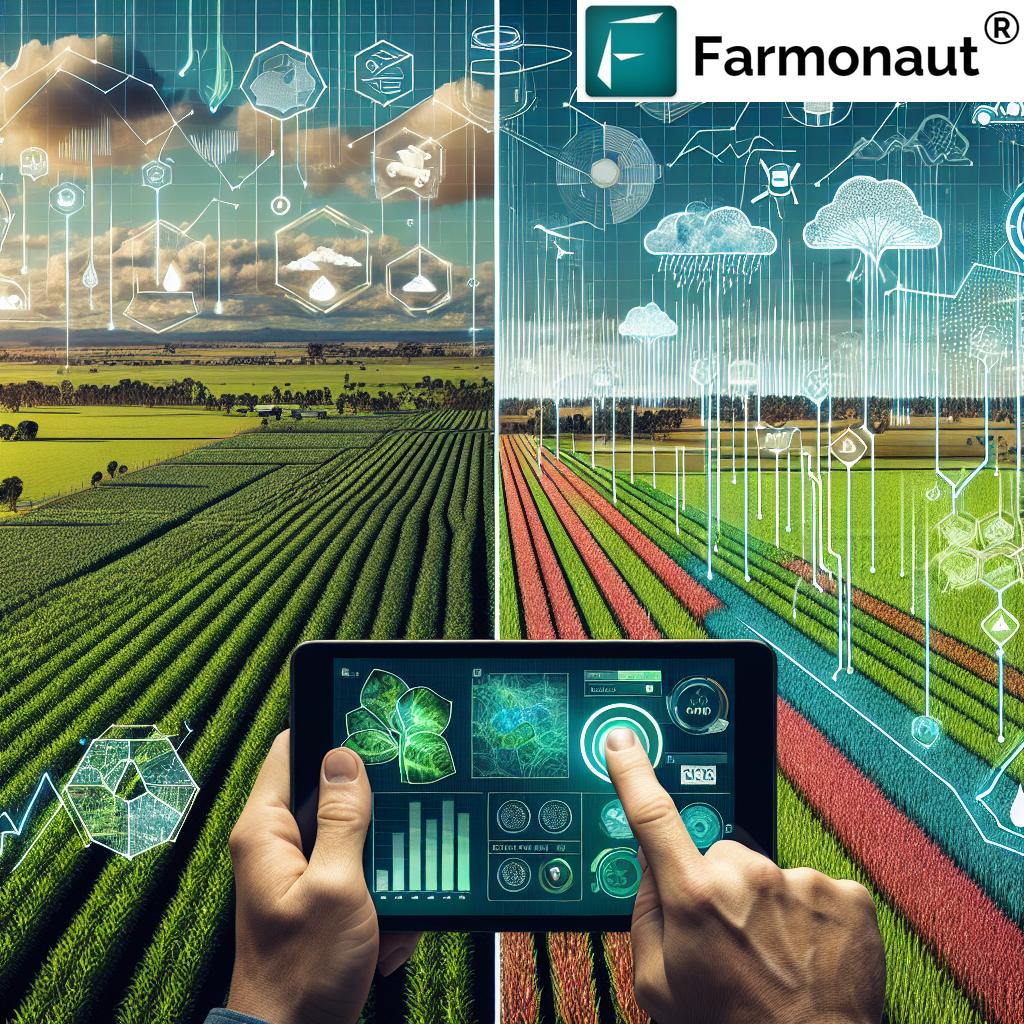Unlocking Orange’s Wine Potential: Precision Viticulture and Sustainable Winegrowing in New South Wales
Welcome to our comprehensive exploration of the Orange wine region in New South Wales, Australia. As we delve into the world of geographical indication wine and cool climate viticulture, we’ll uncover how this unique region is revolutionizing Australian viticulture through sustainable winegrowing practices and precision viticulture techniques. Join us on this journey as we map out the future of wine production in this thriving region.

“Orange wine region in NSW boasts over 60 vineyards and 40 cellar doors across 1,700 hectares of vines.”
The Unique Terroir of Orange: A Cool Climate Paradise
Nestled in the Central Tablelands of New South Wales, the Orange wine region stands out as a cool climate viticulture gem. Its unique topography and climate create a perfect environment for producing distinctive, high-quality wines. Let’s explore the factors that contribute to Orange’s exceptional terroir:
- Elevation: Ranging from 600 to 1,100 meters above sea level
- Climate: Cool continental with Mediterranean influences
- Soil: Diverse, including volcanic basalt and limestone
- Rainfall: Average annual precipitation of 850-1000mm
These elements combine to create ideal conditions for growing a wide variety of grape varieties, particularly those that thrive in cooler climates. The region’s altitude and latitude play crucial roles in moderating temperatures, allowing for a longer growing season and optimal flavor development in the grapes.
Geographical Indication Wine: Orange’s Stamp of Quality
The Orange wine region gained its Geographical Indication (GI) status in 1996, marking it as a distinct wine-producing area with unique characteristics. This GI recognition is crucial for several reasons:
- It defines the boundary of the wine-growing region
- Ensures quality standards and authenticity of wines produced in the area
- Protects the region’s reputation in the global wine market
- Helps consumers identify and trust wines from Orange
The GI status has been instrumental in putting Orange on the map as a premium wine-producing region, attracting both domestic and international attention.
Sustainable Winegrowing: A Commitment to the Environment
At the heart of Orange’s wine industry is a strong commitment to sustainable winegrowing practices. Winegrowers in the region are increasingly adopting environmentally friendly methods to ensure the long-term viability of their vineyards and the surrounding ecosystem.
Key sustainable practices include:
- Water conservation through efficient irrigation systems
- Organic and biodynamic farming methods
- Cover cropping to improve soil health
- Integrated pest management to reduce chemical use
- Energy-efficient winery operations
These practices not only benefit the environment but also contribute to the production of high-quality, terroir-driven wines that reflect the unique characteristics of the Orange region.
Precision Viticulture: Revolutionizing Vineyard Management
The adoption of precision viticulture techniques has been a game-changer for Orange’s wine industry. These advanced technologies allow winegrowers to manage their vineyards with unprecedented accuracy and efficiency.
Some key precision viticulture tools used in Orange include:
- Satellite imagery for crop health monitoring
- Drone technology for detailed vineyard mapping
- Soil sensors for precise irrigation management
- Weather stations for microclimate analysis
- GPS-guided machinery for targeted vineyard operations
At Farmonaut, we’re proud to contribute to this technological revolution in viticulture. Our satellite-based crop health monitoring system provides winegrowers with real-time insights into their vineyards’ health, helping them make data-driven decisions to optimize grape quality and yield.
Wine Region Mapping: Understanding Orange’s Diversity
Accurate mapping of the Orange wine region is essential for understanding its diverse terroir and optimizing vineyard management. GIS (Geographic Information Systems) technology plays a crucial role in this process, allowing for detailed analysis of various factors that influence wine production.
Key aspects of wine region mapping in Orange include:
- Topographic mapping to identify ideal vineyard sites
- Soil type mapping for variety selection and management
- Climate zone mapping for microclimate analysis
- Water resource mapping for irrigation planning
These mapping efforts not only aid in vineyard planning and management but also contribute to the overall understanding of Orange’s unique terroir, helping winemakers craft wines that truly express the region’s character.
Cool Climate Viticulture: Orange’s Competitive Edge
The cool climate of Orange gives the region a significant advantage in producing high-quality wines with distinct characteristics. Cool climate viticulture in Orange offers several benefits:
- Extended growing season for optimal flavor development
- Higher natural acidity in grapes, leading to fresher, more balanced wines
- Lower alcohol levels, resulting in elegant, food-friendly wines
- Ideal conditions for aromatic white varieties and cool-climate reds
These factors contribute to the production of wines that are gaining recognition both nationally and internationally for their quality and unique regional expression.
Grape Varieties and Wine Styles: Diversity in a Bottle
The diverse terroir of Orange allows for the cultivation of a wide range of grape varieties, resulting in an exciting array of wine styles. Some of the key varieties and styles include:
- White Varieties: Chardonnay, Sauvignon Blanc, Riesling, Pinot Gris
- Red Varieties: Shiraz, Cabernet Sauvignon, Merlot, Pinot Noir
- Emerging Varieties: Tempranillo, Sangiovese, Vermentino
The region is particularly noted for its elegant Chardonnays, crisp Sauvignon Blancs, and cool-climate Shiraz wines that showcase the unique terroir of Orange.
Digital Vineyard Management: The Future of Winemaking
Digital vineyard management is transforming the way winegrowers in Orange operate their vineyards. By leveraging technology, they can make more informed decisions and optimize their operations for better quality and efficiency.
Key aspects of digital vineyard management include:
- Real-time monitoring of vine health and growth stages
- Automated irrigation systems based on soil moisture data
- Predictive analytics for pest and disease management
- Digital record-keeping for improved traceability
Farmonaut’s digital solutions, including our mobile and web applications, play a crucial role in this digital transformation. Our tools provide winegrowers with easy access to vital information about their vineyards, enabling them to make data-driven decisions in real-time.
Wine Export Regulations: Navigating Global Markets
As Orange’s reputation grows, so does its presence in international markets. However, navigating wine export regulations can be complex. Key considerations for Orange’s wine exporters include:
- Compliance with international labeling requirements
- Meeting quality standards for different export markets
- Understanding tariffs and trade agreements
- Adhering to organic and biodynamic certification requirements where applicable
Staying informed about these regulations is crucial for wineries looking to expand their reach in the global market.
“Australian wine exports to China dropped by 97% in 2021, prompting a shift in market focus.”
Wine Tourism Marketing: Showcasing Orange’s Beauty
Wine tourism is an integral part of Orange’s wine industry, offering visitors a chance to experience the region’s beauty and taste its wines firsthand. Effective wine tourism marketing strategies include:
- Promoting the region’s scenic beauty and outdoor activities
- Highlighting unique wine tasting experiences and cellar door offerings
- Organizing food and wine festivals to showcase local produce
- Developing wine trails that guide visitors through the region
- Leveraging social media to share the Orange wine experience
These efforts not only boost direct sales but also build brand awareness for Orange wines in the broader market.
Vineyard Emissions Reduction: A Sustainable Future
As climate change concerns grow, the Orange wine industry is taking steps to reduce its carbon footprint. Vineyard emissions reduction initiatives include:
- Implementing renewable energy sources in wineries
- Adopting electric or hybrid vehicles for vineyard operations
- Improving soil management to increase carbon sequestration
- Reducing packaging waste through innovative bottle designs and recycling programs
These efforts not only contribute to environmental sustainability but also resonate with eco-conscious consumers, potentially opening new market opportunities.
The Role of Research and Innovation
Ongoing research and innovation play a crucial role in the continued development of Orange’s wine industry. Key areas of focus include:
- Varietal adaptation to changing climate conditions
- Sustainable pest and disease management techniques
- Water-use efficiency in viticulture
- Precision fermentation techniques for improved wine quality
Collaboration between local wineries, research institutions, and technology providers like Farmonaut is driving these innovations forward, ensuring Orange remains at the forefront of Australian viticulture.

Orange Wine Region GI Profile
| Sub-region | Elevation Range (m) | Avg. Annual Rainfall (mm) | Dominant Soil Types | Key Grape Varieties | Signature Wine Styles | Sustainable Practices Adoption (%) | Precision Viticulture Usage (%) | Annual Wine Production (hL) | Export Market Share (%) | Wine Tourism Visitors (annual) |
|---|---|---|---|---|---|---|---|---|---|---|
| Mount Canobolas | 800-1100 | 950 | Volcanic Basalt | Chardonnay, Pinot Noir | Cool Climate Whites, Sparkling | 85 | 70 | 15,000 | 25 | 50,000 |
| Molong Creek Valley | 600-800 | 850 | Limestone, Shale | Shiraz, Cabernet Sauvignon | Full-bodied Reds | 75 | 65 | 20,000 | 30 | 40,000 |
| Canowindra Hills | 400-600 | 750 | Sandy Loam, Gravel | Sauvignon Blanc, Merlot | Aromatic Whites, Medium-bodied Reds | 80 | 60 | 18,000 | 20 | 35,000 |
The Future of Orange’s Wine Industry
As we look to the future, the Orange wine region is poised for continued growth and innovation. Key trends and opportunities include:
- Increased focus on organic and biodynamic wine production
- Exploration of new grape varieties suited to changing climate conditions
- Further integration of technology in vineyard and winery operations
- Expansion into new export markets, particularly in Asia and North America
- Development of wine tourism experiences that leverage the region’s natural beauty and gastronomy
With its commitment to quality, sustainability, and innovation, Orange is well-positioned to strengthen its place as a premier cool climate wine region on the global stage.
Conclusion: A Bright Future for Orange Wines
The Orange wine region in New South Wales exemplifies the exciting potential of Australian cool climate viticulture. Through a combination of unique terroir, sustainable practices, and innovative technologies, Orange is producing wines that captivate consumers and critics alike. As the region continues to evolve and adapt to changing market demands and environmental conditions, it is clear that Orange will play an increasingly important role in shaping the future of Australian wine.
For those in the wine industry looking to leverage technology for better vineyard management, Farmonaut offers cutting-edge solutions that can help optimize operations and improve wine quality. Our satellite-based crop monitoring and AI-driven advisory systems are designed to give winegrowers the insights they need to make informed decisions throughout the growing season.
Explore Farmonaut’s API for advanced agricultural data integration
Whether you’re a wine enthusiast, industry professional, or simply curious about the intersection of technology and agriculture, the story of Orange’s wine industry offers valuable insights into the future of sustainable and precision viticulture.
FAQ Section
- What makes Orange a unique wine region in Australia?
Orange’s high altitude, cool climate, and diverse soils create a unique terroir that produces distinctive, high-quality wines, particularly cool climate varieties. - How does precision viticulture benefit wine production in Orange?
Precision viticulture techniques allow for more accurate management of vineyards, optimizing grape quality and yield through data-driven decision-making. - What are some key sustainable practices adopted by Orange winegrowers?
Sustainable practices include water conservation, organic farming methods, cover cropping, integrated pest management, and energy-efficient winery operations. - How is technology changing vineyard management in Orange?
Technologies like satellite imagery, drones, soil sensors, and GPS-guided machinery are revolutionizing vineyard management, allowing for more precise and efficient operations. - What grape varieties is Orange known for?
Orange is known for producing excellent Chardonnay, Sauvignon Blanc, Shiraz, and Pinot Noir, among others, with a focus on cool climate styles.




















